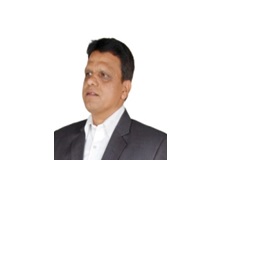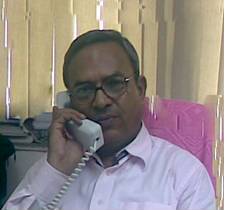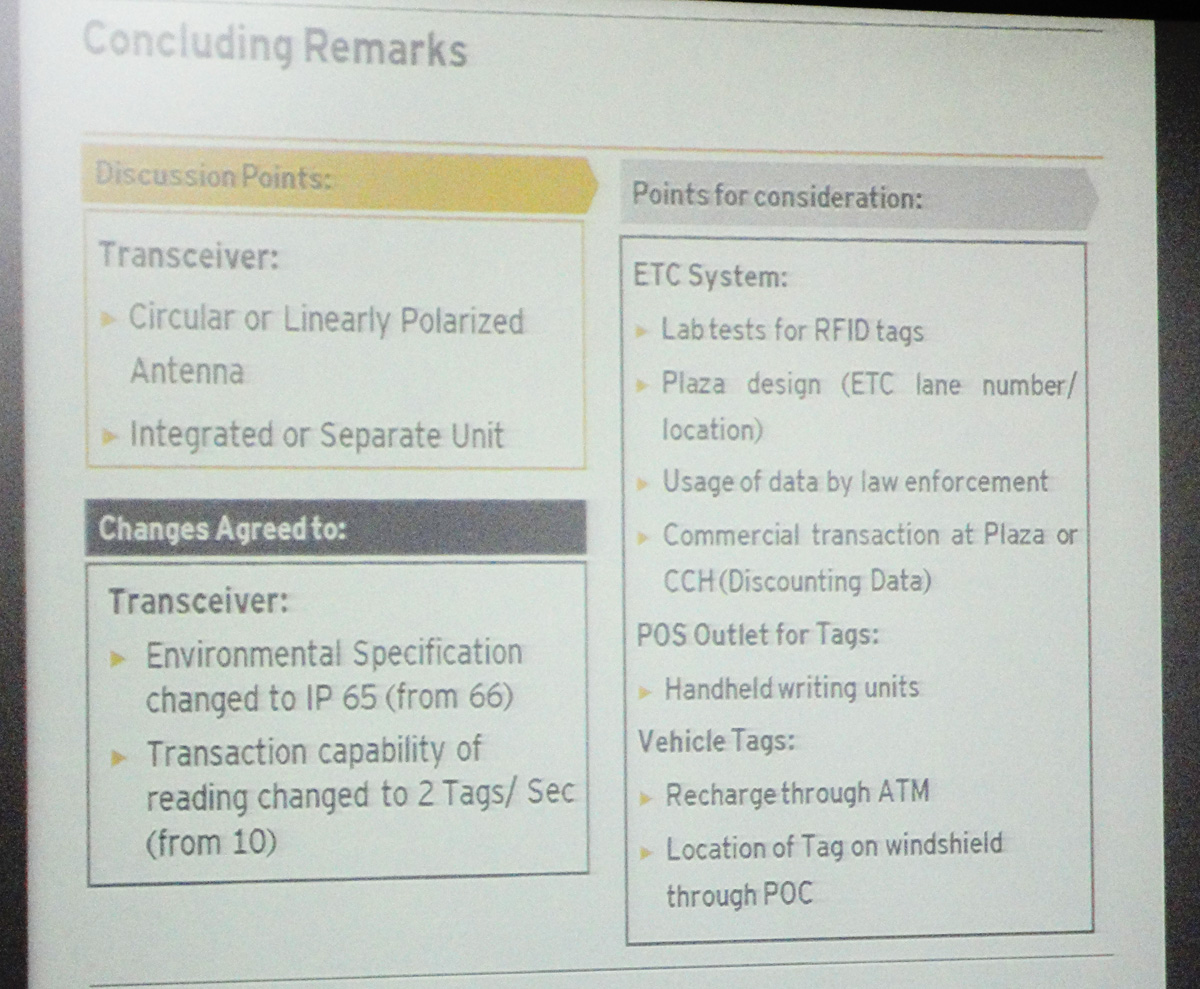Basic Action Plan for Traffic Air Pollution Control -by Sanjay Pardeshi
January 9, 2016
The main reasons for Air Pollutions are:
1) Usage of too much Private Vehicles such as cars and two Wheelers.
2) No Separate defined lanes for two wheeler & cars on all roads resulting conjunction & slow traffic. In such cases, huge exhaust from vehicles polluted city areas tremendously.
3) No Separate left side defined red lane (as per our planning) for public buses, resulting crossing of vehicles, conjunction, traffic jam & huge pollution.
4) Increasing of public transport buses is one of the main solutions to control private cars & two wheelers resulting less pollution & traffic jam.
However these can achieve only when we can standardize all buses, their door positions & bus stops for the same. The separate left side “Red Line” is the key requirement for these buses.
To resolve all above problems & other transport problem, I have made ‘New Road & Transport Planning of Entire India’ for safe, smooth and pollution free travel. This action plan is ready for execution with the help of 20,000 words (approx.) & 134 sketches. This action plan has been demonstrated in the world meeting of International Road Federation (IRF) held in Riyadh.
This action plan consists of 6 innovative ideas & 24 types of standardizations, because of which traffic will regularized by 70% to 80% & accidents will be reduced substantially. Means safe, smooth and pollution free travel for everyone.
These 6 innovative ideas:-
- Separate lane for two wheeler (almost on all roads).
- Parallel parking on the road for all types of vehicles including two wheeler.
- Red line lane at left side for Buses, Auto rickshaw & taxies i.e. for public transport vehicles.
- Four door standardized Bus with unidirectional traffic system (UTS). This Bus will have separate door for ladies & family to get in & out. There will be separate seats for ladies & obviously separate bus stop also.
- Standardization of Bus stand, front infrastructure of Bus stand & railway station.
- BRT (Bus Rapid Transit) :- BRT Will run from left side instead of center of the road.
Similarly there will be 24 types of standardization comprising of different types of vehicles, Bus stops, dividers, bus stand etc.
|
1 |
City/Village internal roads. |
13 |
Buildings of ‘Chota Pariwar’. |
|
2 |
Outer city state / high / express ways. |
14 |
Bus / Electric bus |
|
3 |
Internal city over bridges. |
15 |
School bus / taxies / auto rickshaw |
|
4 |
State / high / express way over bridges. |
16 |
Small, big & share taxi. |
|
5 |
Road over the road. |
17 |
Light Commercial vehicles. |
|
6 |
Sub way & over bridges. |
18 |
Truck & trailer. |
|
7 |
All service roads. |
19 |
City bus stop & place of bus stops. |
|
8 |
Markings on roads Signal Systems. |
20 |
Road side public toilets & toilets in trains |
|
9 |
Parking system for all vehicles. |
21 |
Unidirectional traffic system (UTS) in Bus, railways & everywhere. |
|
10 |
Zebra crossing |
22 |
Intercity Bus stand & its front infrastructure. |
|
11 |
Signal Systems |
23 |
Front infrastructure of railway stations. |
|
12 |
Internal city dividers & state / high / express way dividers |
24 |
Bus Rapid Transit (BRT) |
Above standardization are shown in main 190 pages action plan. Similarly animation of six new ideas is ready & can be seen on www.newroadtransport.com
Any city will be a “smart city” provided it should have separate lane for two wheeler. In above action plan, you will find separate two wheeler lane on almost every road. We all know that India is No. 1 in the road accidents & maximum accidents occurred are of two wheeler. At present two wheeler accident death is the highest in India & hence two wheeler should have then separate lane on the roads. All two wheeler are travel wherever they find place/gap on the road. They don’t have choice. Resulting, though we draw any international standard lane marking on roads, still we will see indiscipline traffic & it is because of non availability of proper lanes, two wheeler lanes is the requirement of the Indian transport system.
Similarly about public transport vehicles, especially for buses. We will draw separate lane for the buses on maximum roads (As shown in the action plan) which will gives cause easier travel for the ladies & children.
The next work is Bus stand & bus stop. Unless we standardized these in the entire country we cannot avoid jostling. You can see animation of these on www.newroadtransport.com.
Similarly about BRT, school taxi, rickshaw, dividers etc. we have to think collectively & minutely on each issue, make standardizations & accordingly execute quality work which is the base of this action plan. Otherwise we will start metro like Delhi but still we find indiscipline rush at outdoor of this metro station like in Delhi.
If we really wish pollution free transportation system like in Dubai or in America, then we have to think on micro levels on all aspects, make action plan (which is ready) & execute it qualitatively without any compromise. If we compromise on each issue, then we will find BRT which are exist now. For example, in Delhi, government invest huge amount to built BRT & then incurred heavy expenses to destroy it. Means wastage of money, time & efforts.
Hence the main feature of ‘New Road & Transport Planning of Entire India’ is a new concept of building complete basic infrastructure of road & transportation system in minimal time, expenses & changes.
Please note, until we built complete basic infrastructure for road & transport, we will not get 100% result of any major projects like metro, BRT etc for road and transportation, Parking and Traffic Air pollution. In any country, first basic infrastructure gets developed as per their needs & then mega projects executed.
Hence we will help / support government people, departments & we will follow this action plan. For these, we can print / read one/two standardization in daily news paper along with sketches which will help us to understand action plan gradually. Once all standardization will be published, we will complied it, the compiled book will be our action plan.
I appeal to all of Indians to join this revolutionary action Plan to make it happen in India.
Author : Sanjay Pardeshi
Sources: www.newroadtransport.com.
Congestion Charging in India,the Government Initiative and the way forward – by Sachin Bhatia , CEO , Metro Infrasys P Ltd
March 28, 2014
 Metro Infrasys Pvt. Ltd. with its head office based in New Delhi is an innovative provider of IT enabled Electronic Systems for Modern Infrastructure, with an impressive track record, in collaborations with top concession companies and Infrastructure Developers in India. At Metro Infrasys, we are driven by the philosophy of dynamic engineering based on reliability. Metro Infrasys provides the best available customized solution in the field of Highway Systems , Urban Traffic and Transport Systems and Security Systems.
Metro Infrasys Pvt. Ltd. with its head office based in New Delhi is an innovative provider of IT enabled Electronic Systems for Modern Infrastructure, with an impressive track record, in collaborations with top concession companies and Infrastructure Developers in India. At Metro Infrasys, we are driven by the philosophy of dynamic engineering based on reliability. Metro Infrasys provides the best available customized solution in the field of Highway Systems , Urban Traffic and Transport Systems and Security Systems.
Mr. Sachin Bhatia ; engineer by qualification has worked in more than 20 Tolling Projects comprising of more than 300 lanes for the last 10 years.
The implementation of the first major ETC System at India’s largest and world’s 4th largest Delhi Gurgaon Toll Plaza on NH-8 is one of his achievements.
Always on look out to develop new technologies for making the projects more innovative and advanced. He has recently launched a new system called FIAOS (Fraud and Internal Audit Online System) for checking the performance of the operator and AVC and also for checking any Closed Lane Violation.
With congestion growing to unmanageable levels , the initiative as per the Press Release from the Ministry of Urban Transportation is right step in the direction.
However in view of the political resistance that is expected against the same, it may be an idea to follow how it is done in the Italian Cities. In Italy, the government implements a restricted access in old city areas wherein using technology the local residents are only allowed in the Old Cities areas. The main concept is that while it is an access restriction, and if someone other than the original owners vehicle accesses the are there is a Penalty which work like a congestion charge, without really calling it a congestion charge. Also the access could be restricted during certain times of the day , depending upon the need for decongestion.
General Description of the Technical Solution and general Operation methodology
Every Vehicle (limited to a maximum number of vehicles per resident) which below to an owners living in the area is granted the access by issuing them a tag. The tag is mapped to the number plate of the vehicle as well. Any vehicle which does not have the tag is considered a violator, and the number plate of the get recorded and a photos is taken of the same.
The system logs into the State Registration database and accesses the records of the registration of the violating vehicle are accessed and a penalty is send to the address of the violator.
The system allows multiple points /modes of the payment and if the vehicle owner does not pay within a stipulated period it the vehicle is blacklisted as offender and impounded.
Press Release of Congestion Charges
The Ministry of Urban Development (MUD), with the objective of reduction of congestion traffic during peak hours, has written to the chief secretaries of states to introduce ‘congestion charge’ in cities.
The concept of congestion charge, although relatively unknown in India, has been effectively implemented in cities like London, New York, Milan and Singapore. Levying of this charge would mean that vehicles driven into congested areas of a city would have to pay an entry fee or heavy parking charges. The congestion charge would deter people from taking private vehicles to congested areas of cities and encourage them to use public transport. This would result in lesser number of vehicles on roads.
The letter written by MUD secretary Sudhir Krishna states: “Now-a-days mobility in our cities, either big or medium, is a huge challenge due to congestion during peak hours, which is mainly due to excessive use of private vehicles. There is a need to resolve the congestion issues urgently for improving mobility of the people.”
The problem of congestion may be partly resolved by adopting Transport Demand Management (TDM) strategies to ensure that the economic development of our cities is decoupled from excessive motorization by encouraging investments in sustainable transports like public transport, cycling and walking, the letter read.
Due to the demographic, business and archaeological compulsions in certain areas in the cities, de-congesting is a tough process, Krishna added in the letter.
The letter was sent along with case studies of London and Singapore, which show impressive results.
With the levying of the charge, traffic in Central London went down by about 21 per cent and the traffic speed went up by about 10 per cent.
The MUD’s letter suggested a manual permit/ coupon system, as was done in Singapore, when it first introduced congestion pricing. London uses automatic number plate recognition cameras at entry sites around the core areas of the city to record the vehicles. Those incurring the charge then pay it online, through mobiles or at specific stores and those failing to pay the charge get fined, the MUD said.
There is a need to discourage use of private vehicles in the core areas of cities so that people can reach offices, workplaces and business centers in time.
This can be achieved by proper TDM and consequent levying of congestion charges on the vehicles entering the specified zone. The congestion pricing is premised on a basic concept — “charge a price in order to allocate a scarce resource to its most valuable use” the letter read.
Press Information -MHI’s RFID based ETC System Begins Commercial Operation in India, Helping to Ease Traffic Congestion and Preserve the Environment
December 5, 2013
Tokyo,
The electronic toll collection (ETC) system operating by radio frequency identification (RFID) equipment supplied by Mitsubishi Heavy Industries, Ltd. (MHI) began commercial operation on an expressway in India’s Gujarat state. The system, involving RFID readers installed at toll plazas to detect in-vehicle adhesive RFID tags and collect tolls, will contribute to easing of traffic congestion and to preservation of the country’s environment. The event marks the first supply of an RFID based ETC system to India from Japan.
MHI provided the major equipment comprising the RFID based ETC system including 30 sets of RFID readers. The equipment was ordered by KENT Intelligent Transportation Systems (India) Private Limited, an Indian toll collection system integrator. The ETC equipment provided by MHI complies with Indian national standards and communicates with the RFID tag which is distributed for the ETC operation under regulations in India. MHI delivered RFID equipment newly designed dedicated for ETC operation.
The newly inaugurated RFID based ETC system is in operation on a 95-kilometer (km) highway connecting Ahmedabad, the largest city in Gujarat, and Vadodara, the state’s third-largest city, operated by IRB Infrastructure Developers Ltd, a leading road concessioner in India. It marks the country’s first fully access-controlled expressway. It encompasses a total of 59 lanes at 6 tollgates, of which 28 lanes are equipped with the new RFID based ETC system.
While motorization has been making rapid progress in India in tandem with the country’s steady economic growth, road infrastructure is needed to keep pace with this development. To rectify the situation, Indian governments and road concessionaires are now focusing on improving the nation’s road network, and installation of the RFID based ETC system is part of that broad initiative.
MHI is a supplier of comprehensive ETC system and Intelligent Transport System (ITS). The company has an abundant track record of deliveries both at home in Japan and overseas. Gaining momentum from its introduction in India, going forward MHI aims to further strengthen its marketing activities for various ETC systems suited to the needs and conditions of each country.

Toll gate at main road in Ahmedabad

RFID tag
Source-http://www.mhi.co.jp
Approval for development of four laning of Solapur-Yedeshi section of NH 211 in the State of Maharashtra under NHDP Phase IV
September 25, 2013
Government of India
Cabinet Committee on Economic Affairs (CCEA)
The Cabinet Committee on Economic Affairs has given its approval for four laning of the Solapur-Yedeshi section of National Highway-211 in the state of Maharashtra under the National Highways Development Project (NHDP) Phase IV on Build, Operate and Transfer (BOT-Annuity) in Design, Build, Finance, Operate and Transfer (DBFOT) pattern.
The cost is estimated to be Rs.1,057.82 crore including the cost of land acquisition, resettlement and rehabilitation and other pre-construction activities. The total length of the road will be approximately 99 kms.
The project will expedite improvement of infrastructure in the State of Maharashtra and also reduce the time and cost of travel for traffic, particularly heavy traffic, plying between Solapur and Yedeshi. This road stretch runs between the Solapur-Yedeshi section of NH-211. Development of this stretch will also help in uplifting the socio-economic condition of this region of the State of Maharashtra. It will also increase employment potential for local labourers for project activities.
Source- http://pib.nic.in
Mr. S. CHAKRAVARTY, Secretary – ATTSII
October 20, 2011
Mr. S. Chakravarty, formerly General Manager, RITES Limited has taken over as the Secretary, ATTSII after his retirement. He brings with him a good 33+ years of rich experience in Telecom and associated fields. Of this, he has spent almost eleven years working for the ITS industry in India on behalf of RITES, in addition to many other prestigious projects including Delhi Metro, Ennore Coal Port Project and Hyderabad Metro, to name a few.
Mr. Chakravarty has several firsts to his credit including the planning and implementation of the first-ever HTMS (Highway Traffic Management System) in India on the Kotputli-Amer section of NH8 during 1999-2001 for NHAI. He has also provided consultancy to NHAI for planning, design and tender documentation for a good number of HTMS / Tolling / WIM (Weigh-in-motion) systems in various parts of India. He was also instrumental in creating the basic tender specifications for the ITS project of Delhi Police prior to the Commonwealth Games in Delhi in 2010.
Prior to RITES he had useful stints in the erstwhile Overseas Communications Service (now called Videsh Sanchar Nigam Limited) and Bharat Electronics Limited where also he has several firsts under his belt. His rich experience in technology as well as having been a key player in major infrastructure projects in India makes him a fit candidate to function as Secretary, ATTSII.
Covered By
Editor
Indian Tollways
Kapsch TrafficCom consortium successfully launches ETC system in Poland Traffic Technology
July 7, 2011
The Polish Directorate for National Roads and Highways (GDDKiA) has said that the Kapsch TrafficCom consortium has successfully launched the country’s ‘viaToll’ electronic toll collection (ETC) system this week. The Kapsch consortium has implemented a comprehensive and state-of-the-art ETC system on the existing road network of approximately 1,560km (970 miles), which applies to all vehicles weighing over 3.5 tons. The consortium will also provide commercial operation of the system for the next eight years through its Polish operation’s company and will continue to extend the existing system to additional roads during the operational period. The Polish Finance Ministry expects that the system will increase the country’s revenues by about US$145 million (PLN400 million) by the end of this year.
“The entire system is now operational,” enthused Michael Gschnitzer, Kapsch TrafficCom’s sales director. “Until today we had successfully registered more than 300,000 vehicles – in the upcoming days we expect to distribute around 25,000 onboard units daily. As a result of the big interest of the road users, we extended the capacity and working hours on most of the points of sale. The mobile enforcement units already successfully control whether vehicles above 3.5 tons are properly equipped with OBUs. The system was implemented in record time. For the whole implementation, we had not more than eight months. There is still enough to do for us, but the system could now successfully go into operation.”
Workshop on Nationwide Electronic Toll Collection, held at Vigyan Bhawan, New Delhi on June 14, 2011
June 15, 2011
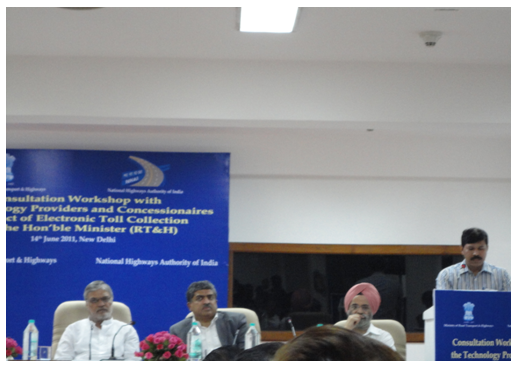
Workshop on Nationwide Electronic Toll Collection
- Mr. C P Joshi , Honrable Minister Road Transport and Highways
- Mr. Nandan Nilkani , Chairman , UIDAI
- Mr. R S GUJRAL , Chairman NHAI
- Mr. Ravi Palekar , GM (Electronics) , NHAI – Addressing the gathering
- Mr. Sachin Bhatia, CEO, Metro Infrasys
Workshop on Nationwide Electronic Toll Collection held at Vigyan Bhawan, New Delhi. With an objective of paving way for a unified Electronic Toll Collection (ETC) technology for National Highways in India, the Ministry of Road Transport & Highways constituted a Committee under the chairmanship of Shri Nandan Nilekani Chairman of UIDAI with a mandate to examine all technologies available for Electronic Toll Collection (ETC) and recommend the most suitable one for implementation throughout India. The other members of the Committee are Prof. Pankaj Jalote, Director, IIIT-Delhi ; Dr. Kolin Paul, Asst. Professor, IIT-Delhi ; Shri A.V. Sinha, DG (Road Development) & Special Secretary, MoRT&H and Shri. V.L. Patankar, Member (Technical), NHAI (Member Secretary).
The Union Minister for Road Transport & Highways Dr. C.P. Joshi has said that we should chalk out a plan to increase the percentage of national highways from present 2.2 % to 5 % in the next 10 years. Delivering inaugural address at the Consultation Workshop with the Technology Providers and Concessionaires in respect of Electronic Toll Collection (ETC) here today, he said that keeping in view the various types of highways there should be a hybrid pattern of toll collection. The Workshop was jointly organized by Ministry of Road Transport & Highways, National Highways Authority of India & National Informatics Centre. The Chairman of UIDAI Shri Nandan Nilkeni & Minister of State for RT&H Shri Tusharbhai A. Chaudhary also addressed the workshop. Shri R.S. Gujral, Secretary Ministry of Road Transport & Highways and Dr. V.K. Gairola, D.G (NIC) were present.
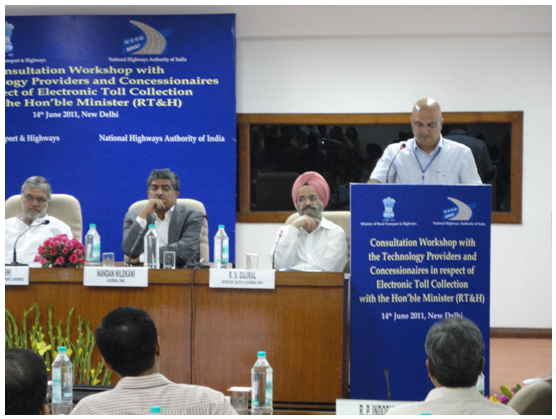
Mr. Sachin Bhatia CEO Metro Infrasys expressing the support from Industry Fraternity
Based on the recommendations of the committee headed by Mr. Nandan Nilekani to use RFID technology for ETC, the Apex Committee, responsible for ETC implementation planning, is in the process of prescribing certain standards which should be complied with all over the country to ensure interoperability. The primary purpose of this workshop was to take feedback from the key stakeholders, comprising concessionaires and ETC technology service providers. Security, cost effectiveness, convenience and scalability have been the main criteria based on which the detailing has been done.
Based on the feedback, the specifications and data detailing will be finalized for open market release. The plan is that the authorized manufacturers will be producing Transceivers and Tags based on these standards, the concessionaires will be procuring these Transceivers and in turn, the technology service providers will be integrating the entire ETC system at the toll plaza. Although details on other aspects like clearing house are being worked out simultaneously, majority of the decisions will depend upon these standards only.
Followings are the Tolling Companies, RFID Manufacturer and concessionaire took part in the workshop:
- Kapsch Metro
- Egis Infra
- L&T Infra
- GMR
- HCC Infrastructure
- JICA
- IRDSA
- DSC
- EFKON India
- Siemens
- IAITO Infotech Pvt. Ltd.
- ESSEN, Mumbai
- ATT System, Banglore
- Mitsubishi
- IBI Group
- Neology
- Steria
- Tag Factory
Brief of discussion over finalization of technology between committee and Industry Peoples:
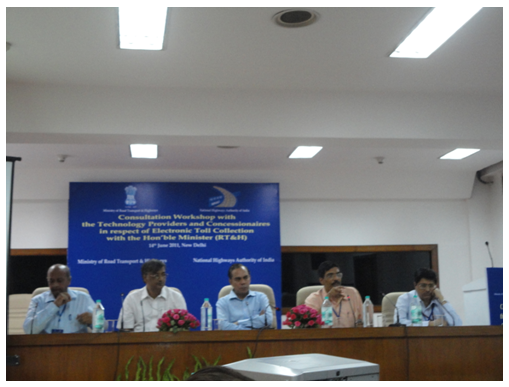
- Dr. B.K. Gairola, Director General, NIC – extreme left
- Dr. Y.K. Sharma, DDG, NIC - middle position
- Dr. Rajat Moona, Director General of CDAC, IIT Kanpur
- Dr. Y.K. Sharma, DDG, NIC - extreme Right
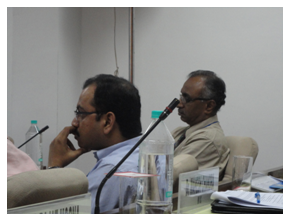 Mr. Venkat from GMR expressed change from IP 66 to IP 65 for the readers as IP 65 is also good enough and IP 66 will increase the cost for the readers without any additional value.
Mr. Venkat from GMR expressed change from IP 66 to IP 65 for the readers as IP 65 is also good enough and IP 66 will increase the cost for the readers without any additional value.
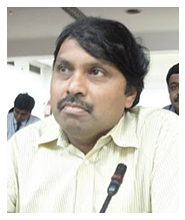 Mr. Hari from Efkon
Mr. Hari from Efkon
He raised an issue over the relative humidity of 100% for Transceiver antenna.
Committee Conclusion :
Committee agreed for the IP 65 standard and 95% relative humidity as it comply against all possible environmental threat at toll scenario.
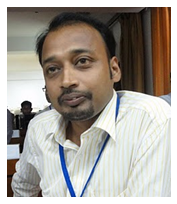 Mr. Anand Shenoy from IAITO Infotech Pvt. Ltd.
Mr. Anand Shenoy from IAITO Infotech Pvt. Ltd.
Raised his voice over minimum requirement of reading of 10 Tags per second with 240 bits of EPC memory and 64 bits of Tag Id.
Committee Conclusion: committee agreed onto change it to 2 Tags per second with above said minimum requirement. On the other query raised by Mr. Shenoy that the data retention period must be 3-4 year for the tag memory instead of 10 years as their is no UV protection asked for the tag and without any special material with the effect of UV rays its hard to maintain the data in tag for 10 years, The committee replied as they will keep it under consideration and if required they will bring it in next phase.
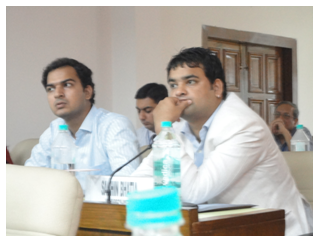 On the query raised by Team from Metro Infrasys- Mr. Nitin Thakur and Mr. Harimohan for the option of having color coded Tags for different class of vehicles, as it will help in operation at toll plazas. The Committee said that it is difficult to see the color in the moving car in the sun. However committee will discuss it in next phase.
On the query raised by Team from Metro Infrasys- Mr. Nitin Thakur and Mr. Harimohan for the option of having color coded Tags for different class of vehicles, as it will help in operation at toll plazas. The Committee said that it is difficult to see the color in the moving car in the sun. However committee will discuss it in next phase.
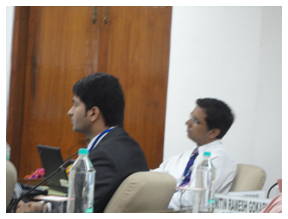 Mr. Vipul Sharma(Left), Mr. Mayank Manish(Right)
Mr. Vipul Sharma(Left), Mr. Mayank Manish(Right)
The long discussed topic was the polarization standard for the antenna, Panel has asked for circular polarization pattern for the antenna but Mr. Vipul Sharma and Mayank Manish from one of the leading manufacturer of RFID Equipment Neology reasoned to have it linearly polarized due to its long range and less interference phenomenon, also linearly polarized antennas can work at higher speed , committee keep this for discussion and will revert again.
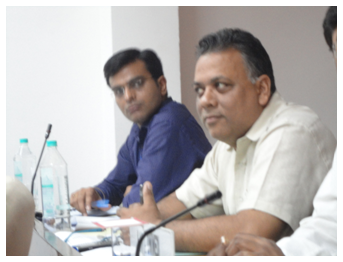 Mr. Manoj Agarwal and Mr. Manish from Delhi Gurgaon Expressway strongly supported the idea of a law for putting a penalty on cash vehicles coming to Tag lane .
Mr. Manoj Agarwal and Mr. Manish from Delhi Gurgaon Expressway strongly supported the idea of a law for putting a penalty on cash vehicles coming to Tag lane .
For the standard for the communication between plaza server and CCH server, there will be addition of Plaza id into the prescribed format by the committee. Plaza level fare plan and policy will be governed by the plaza itself while the global discount will be governed by the CCH server and will be updated in all the plaza server by CCH server itself. Committee also agreed to look into the various aspects of fare plans at different plazas.
Highlights of the Workshop:
ETC critical components:
Tag Distribution Channel & Inventory Management
- On-line channels by user
- Authorized service centers of vehicles (Service centre need to install the SPV client software and antenna connection), since centre must have authorized people to affix tags.
- RTO(Operation is similar to above)
- Vehicle dealer network(Operation is similar to above)
- Authorized point of sale installation(POS can be insurance companies, PUC centers, Petrol Pumps etc; Operation is similar to above)
Inventory Management of Tags:
SPV will keep track of allocated EPC Ids, Tag Ids etc. It will perform a demand forecast Tags and keep the tags available for distribution through distribution channel.
Handling Special Cases
- Valid ETC enabled vehicle was ejected due to non-read of Tag – Premium cash lane should verify it with the ETC database.
- Clone Tag – If customer complains/suspects that his/her Tag is cloned, Tag re-initiation is to be done for same Tag. Old Tag value is marked for special handling.
- Change in registration number of vehicle – Vehicle should approach distribution channel network and get a new tag. Old tag is to be destroyed physically and listed for special handling.
- De-registration of vehicle (due to destruction/ end of life/ Export etc.)-Tag is to be destroyed physically and listed for special handling.
Listing for Special Attention
Vehicle is listed for special attention following conditions:
- Insufficient balance as determined by clearing house
- Credit card co. declined the payment
- On Police look-out
- Suspected cloned Tag
- Tag with invalid Vehicle Registration no. (e.g. when Registration no. is changed)
- When toll plaza operator notices Tag carrying details different from vehicle itself (e.g. the vehicle Registration no. and/ or Vehicle class)
Videos
Conclusions drawn at the end of the seminar:
Documents Attached:
- Agenda Workshop
- Apex Committee for ETC Implementations – GOI, Draft Specifications Document
- ETC Report on RFID – July 2010
 This story is covered by Mr. Sachin Bhatia.
This story is covered by Mr. Sachin Bhatia.
We will be awarding 7300 km minimum this year: NHAI
June 9, 2011
In an interview with ET Now, Dr. JN Singh , Director Finance, NHAI, talks about the NHAI’s future projects and future strategy. Excerpts:
ET Now: Could you outline for us the quantum of new orders you have released in the first two months of this financial?
Dr. JN Singh: Around 1000 kms is what we have already released this year so far in the first two months. We are geared for around say 700-800 km in the next quarter as well per month.
ET Now: So can I safely assume that you will meet your guidance of awarding new contracts of at least 7500 crores?
Dr. JN Singh: Yes, 7300 km is what we definitely feel that we will be achieving this year. Most of the awards we expect right now that will be completed by December-January itself and we are fully geared for that. The feasibility reports are very well prepared. The land acquisition is substantially in place, and the things look okay right now.
ET Now: But lately we have seen that there have been several issues as far as land acquisition is concerned. Recently there has been widespread violence in Uttar Pradesh over land acquisition. How is NHAI looking to tackle this problem?
Dr. JN Singh: Fortunately as far as NHAI is concerned, we have not experienced such type of opposition so far. Maybe this opposition is because the UP projects are also taking commercial ventures along with the road and that’s what angers farmers or the land holders. As far as NHAI is concerned, it is doing purely a road building. It is not so far at least is mixing commercial ventures with the roadside. So that’s why though there would be some complaints about the lower rate that we are offering or at times people would like to go to arbitration for land acquisition but there has been no concerted move at any place, anywhere in the country that land acquisition as far as NHAI is concerned is a problem. It is of course an issue.
Click here to read full conversation
Kapsch TrafficCom delivers 30,000 transponder units for the Eazy Pass electronic toll system in Ireland
September 12, 2008
Kapsch TrafficCom AG has secured an order for the first Eazy Pass electronic toll system in Dublin. The company has satisfied the particularly demanding criteria of Eazy Pass and is to supply 30,000 transponder units (or tags for short) to Ireland. Eazy Pass will be used on the new M50 toll route in Dublin. The system will also allow barrier-free driving throughout Ireland. Eazy Pass enables electronic payment at all Irish toll stations, without the need to stop.
The latest order for Kapsch TrafficCom comes from Ireland. The Kapsch TrafficCom subsidiary Kapsch TrafficCom Ltd. is to supply 30,000 transponder units to Dublin. These will be used in the first electronic toll system Eazy Pass on the new M50 toll route in Dublin. Eazy Pass is now also accepted on the N4/N6 Kilcock-Kinnegad, N8 Fermoy Bypass, Dublin Port Tunnel, East-Link and M1 Dundalk Western Bypass. Within the scope of this order, Kapsch will supply transponder units for passenger cars and tags for goods vehicles.
“We have worked with Kapsch TrafficCom since we pioneered electronic tolling in Ireland. Kapsch is our principle technology supplier and a real key partner. We are therefore very pleased that Kapsch TrafficCom has been able to meet our requirements in order to support us in what is a particularly important step towards the expansion of electronic tolling in Ireland,” explains Dermot MacEvilly, CEO of Eazy Pass.
Vienna, 12th September 2008
For further information:
Brigitte Herdlicka
Public Relations & Sponsoring
Kapsch Group
Phone: +43 (0) 50 811 1705
A-1120 Vienna, Wagenseilgasse 1
E-mail: [email protected]
www.kapschtraffic.com
www.kapsch.net
Kapsch TrafficCom delivers Toll Systems for Urban Motorways in Bangkok
September 4, 2008
Kapsch TrafficCom impresses yet again with a new project in Asia: The company is constructing modern toll systems for three of the largest motorways in Bangkok. Kapsch TrafficCom Sweden will be working with two Thai companies under the joint venture FKS. The order for more than 55 kilometres of motorway in total will be completed in August 2009. Its worth is estimated at 8.5 million euros.
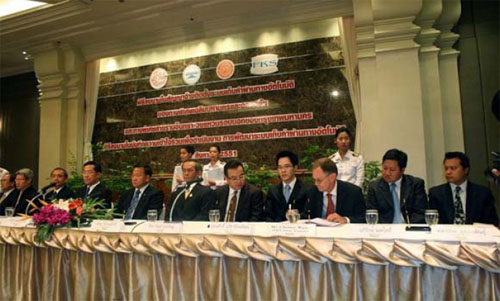
(Signing of contract – Christer Weiner, Kapsch TrafficCom Sweden, together with the Thai partners and customers)
As from autumn 2009, visitors to Bangkok will be escorted on their journey into the centre of the city by Austrian toll equipment. For Kapsch TrafficCom was able to notch up an order recently to fit out three large motorways in Bangkok. More specifically, the company will install the system by order of the Expressway & Rapid Transit Authority of Thailand (EXAT), in cooperation with the two Thai companies Fatima Group and Smart Traffic Co Ltd – as FKS Joint Venture. The Chalerm Maha Nakhon Expressway (consisting of three sections with a total length of 27.1 kilometres), the Chalong Rat Expressway (six-lane with a length of 18.7 km) and the Ramindra Outer Ring Project (with a total length of 9.5 kilometres) are set to be equipped with toll systems.
“Kapsch TrafficCom has repeatedly been successful in Asia. By replacing the 8-year old equipment and upgrading the electronic toll system, the flow of traffic on these three motorways will be sped up and traffic jams will to a large extent be avoided. This was possible primarily because of the extensive expertise of our employees and due to our many years of experience on the Asian market”, declares Erwin Toplak, Member of the Board, Kapsch TrafficCom AG.
The contract to set up the largest electronic toll system to date and a central system for registering and guiding traffic comprises altogether 80 lanes. The new infrastructure will include 100,000 CEN DSRC compatible transponders, 100,000 non-contact smart cards and other equipment (i.a. server equipment, a network and a CCTV video camera system). The system will be completed in autumn 2009 and comprises an order volume of approximately 8.5 million euros.
Kapsch TrafficCom is an international supplier of innovative road traffic telematics solutions. Its principle business is the development and supply of electronic toll collection (ETC) systems, in particular for the multi-lane free-flow (MLFF) of the traffic, and the technical and commercial operation of such systems. Kapsch TrafficCom also supplies traffic management systems, with a focus on road safety and traffic control, and electronic access systems and parking management. With more than 140 reference projects in 30 countries in Europe, Australia, Latin America, in the Asian/Pacific region and in South Africa, and with almost 12 million on-board units (OBUs) and nearly 11,000 equipped lanes, Kapsch TrafficCom has positioned itself among the leading suppliers of ETC systems worldwide. Kapsch TrafficCom is headquartered in Vienna, Austria, and has subsidiaries and representative offices in 20 countries.
For further information:
Brigitte Herdlicka
Public Relations & Sponsoring
Kapsch Group
Phone: +43 (0) 50 811 1705
A-1120 Vienna, Wagenseilgasse 1
E-mail: [email protected]
www.kapschtraffic.com
www.kapsch.net
